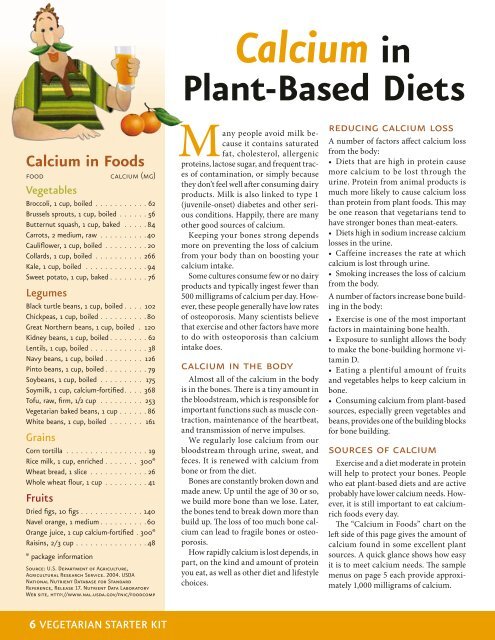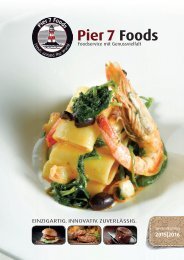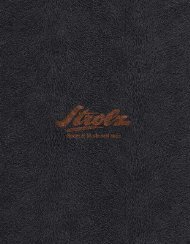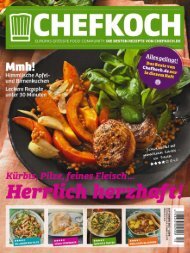testff
testfff
testfff
You also want an ePaper? Increase the reach of your titles
YUMPU automatically turns print PDFs into web optimized ePapers that Google loves.
Calcium in Foods<br />
food calcium (mg)<br />
Vegetables<br />
Broccoli, 1 cup, boiled . . . . . . . . . . . 62<br />
Brussels sprouts, 1 cup, boiled . . . . . . 56<br />
Butternut squash, 1 cup, baked . . . . . 84<br />
Carrots, 2 medium, raw . . . . . . . . . . 40<br />
Cauliflower, 1 cup, boiled . . . . . . . . . 20<br />
Collards, 1 cup, boiled . . . . . . . . . . 266<br />
Kale, 1 cup, boiled . . . . . . . . . . . . . 94<br />
Sweet potato, 1 cup, baked . . . . . . . . 76<br />
Legumes<br />
Black turtle beans, 1 cup, boiled . . . . 102<br />
Chickpeas, 1 cup, boiled . . . . . . . . . . 80<br />
Great Northern beans, 1 cup, boiled . 120<br />
Kidney beans, 1 cup, boiled . . . . . . . . 62<br />
Lentils, 1 cup, boiled . . . . . . . . . . . . 38<br />
Navy beans, 1 cup, boiled . . . . . . . . 126<br />
Pinto beans, 1 cup, boiled . . . . . . . . . 79<br />
Soybeans, 1 cup, boiled . . . . . . . . . 175<br />
Soymilk, 1 cup, calcium-fortified . . . . 368<br />
Tofu, raw, firm, 1⁄2 cup . . . . . . . . . 253<br />
Vegetarian baked beans, 1 cup . . . . . . 86<br />
White beans, 1 cup, boiled . . . . . . . 161<br />
Grains<br />
Corn tortilla . . . . . . . . . . . . . . . . . 19<br />
Rice milk, 1 cup, enriched . . . . . . . 300*<br />
Wheat bread, 1 slice . . . . . . . . . . . . 26<br />
Whole wheat flour, 1 cup . . . . . . . . . 41<br />
Fruits<br />
Dried figs, 10 figs . . . . . . . . . . . . . 140<br />
Navel orange, 1 medium . . . . . . . . . . 60<br />
Orange juice, 1 cup calcium-fortified . 300*<br />
Raisins, 2/3 cup . . . . . . . . . . . . . . . 48<br />
* package information<br />
Source: U.S. Department of Agriculture,<br />
Agricultural Research Service. 2004. USDA<br />
National Nutrient Database for Standard<br />
Reference, Release 17. Nutrient Data Laboratory<br />
Web site, http://www.nal.usda.gov/fnic/foodcomp<br />
6 VEGETARIAN STARTER KIT<br />
Calcium in<br />
Plant-Based Diets<br />
M<br />
any people avoid milk because<br />
it contains saturated<br />
fat, cholesterol, allergenic<br />
proteins, lactose sugar, and frequent traces<br />
of contamination, or simply because<br />
they don’t feel well after consuming dairy<br />
products. Milk is also linked to type 1<br />
(juvenile-onset) diabetes and other serious<br />
conditions. Happily, there are many<br />
other good sources of calcium.<br />
Keeping your bones strong depends<br />
more on preventing the loss of calcium<br />
from your body than on boosting your<br />
calcium intake.<br />
Some cultures consume few or no dairy<br />
products and typically ingest fewer than<br />
500 milligrams of calcium per day. However,<br />
these people generally have low rates<br />
of osteoporosis. Many scientists believe<br />
that exercise and other factors have more<br />
to do with osteoporosis than calcium<br />
intake does.<br />
calcium in the body<br />
Almost all of the calcium in the body<br />
is in the bones. There is a tiny amount in<br />
the bloodstream, which is responsible for<br />
important functions such as muscle contraction,<br />
maintenance of the heartbeat,<br />
and transmission of nerve impulses.<br />
We regularly lose calcium from our<br />
bloodstream through urine, sweat, and<br />
feces. It is renewed with calcium from<br />
bone or from the diet.<br />
Bones are constantly broken down and<br />
made anew. Up until the age of 30 or so,<br />
we build more bone than we lose. Later,<br />
the bones tend to break down more than<br />
build up. The loss of too much bone calcium<br />
can lead to fragile bones or osteoporosis.<br />
How rapidly calcium is lost depends, in<br />
part, on the kind and amount of protein<br />
you eat, as well as other diet and lifestyle<br />
choices.<br />
reducing calcium loss<br />
A number of factors affect calcium loss<br />
from the body:<br />
• Diets that are high in protein cause<br />
more calcium to be lost through the<br />
urine. Protein from animal products is<br />
much more likely to cause calcium loss<br />
than protein from plant foods. This may<br />
be one reason that vegetarians tend to<br />
have stronger bones than meat-eaters.<br />
• Diets high in sodium increase calcium<br />
losses in the urine.<br />
• Caffeine increases the rate at which<br />
calcium is lost through urine.<br />
• Smoking increases the loss of calcium<br />
from the body.<br />
A number of factors increase bone building<br />
in the body:<br />
• Exercise is one of the most important<br />
factors in maintaining bone health.<br />
• Exposure to sunlight allows the body<br />
to make the bone-building hormone vitamin<br />
D.<br />
• Eating a plentiful amount of fruits<br />
and vegetables helps to keep calcium in<br />
bone.<br />
• Consuming calcium from plant-based<br />
sources, especially green vegetables and<br />
beans, provides one of the building blocks<br />
for bone building.<br />
sources of calcium<br />
Exercise and a diet moderate in protein<br />
will help to protect your bones. People<br />
who eat plant-based diets and are active<br />
probably have lower calcium needs. However,<br />
it is still important to eat calciumrich<br />
foods every day.<br />
The “Calcium in Foods” chart on the<br />
left side of this page gives the amount of<br />
calcium found in some excellent plant<br />
sources. A quick glance shows how easy<br />
it is to meet calcium needs. The sample<br />
menus on page 5 each provide approximately<br />
1,000 milligrams of calcium.

















